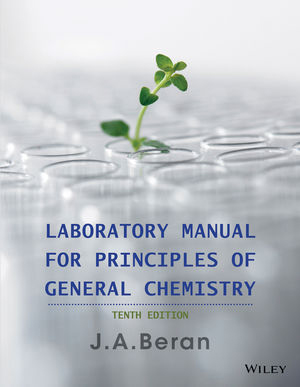
Laboratory Manual for Principles of General Chemistry, 10th Edition
By J.A. Beran
A lab manual for the General Chemistry course, Beran’s Laboratory Manual for Principles of General Chemistry offers a broad selection of experiments and a clear layout and design. Containing enough material for two or three terms, this lab manual emphasizes chemical principles as well as techniques. In addition, the manual helps students understand the timing and situations for various techniques.
Schedule a Demo Sign Up for a Test Drive Adopt WileyPLUSWant to learn more about WileyPLUS? Click Here
Wiley Engage Learning Platform
Engage is a moodle-based product and allows instructors to assign the pre- and post-lab questions online with automatic grading and feedback. This course is fully customizable and can be tailored to include your own lab questions.
Pre-Lab Questions
Designed to facilitate the analysis of data in the experiment, the pre-lab questions appear in those experiments that require quantitative results.
Pre-Lab Assignments
Students are prompted to analyze representative experimental data in the pre-lab assignments, specific to experiments that require such analysis.
Data Analysis Section
A greater emphasis on presenting and analyzing experimental data is incorporated.
Report Sheets
Now more user-friendly, report sheets have been reformatted to allow more calculation space for students to work with their data.
Dr. Jo Allan Beran is a Regents Professor of Chemistry at Texas A&M University System. He has published a combined total of 30 texts and lab manuals on chemistry as well as 19 articles in various journals. Dr. Beran is a member of American Chemical Society (ACS) and the Texas Association of College Teachers (TACT).
Laboratory Safety and Guidelines
Data Documentation
Data Analysis
Laboratory Techniques
A. Introduction
Dry Lab 1: The Laboratory and SI
Experiment 1: Basic Laboratory Operations
B. Chemical and Physical Properties
Experiment 2: Identification of a Compound: Chemical Properties
Experiment 3: Water Analysis: Solids
Experiment 4: Paper Chromatography
Experiment 5: Percent Water in a Hydrated Salt
Experiment 6: Acids, Bases, and Salts
Dry Lab 2A: Inorganic Nomenclature I. Oxidation Numbers
Dry Lab 2B: Inorganic Nomenclature II. Binary Compounds
Dry Lab 2C: Inorganic Nomenclature III. Ternary Compounds
C. Mole Concept
Experiment 7: Empirical Formulas
Experiment 8: Limiting Reactant
Experiment 9: A Volumetric Analysis
Experiment 10: Vinegar Analysis
D. Atomic and Molecular Structure
Experiment 11: Periodic Table and Periodic Law
Dry Lab 3: Atomic and Molecular Structure
E. Gases
Experiment 12: Molar Mass of a Volatile Liquid
Experiment 13: A Carbonate Analysis; Molar Volume of Carbon Dioxide
F. Solutions
Experiment 14: Molar Mass of a Solid
Experiment 15: Synthesis of Potassium Alum
G. Acid-Base Equilibria and Analysis
Experiment 16: LeChâtelier’s Principle; Buffers
Experiment 17: Antacid Analysis
Experiment 18: Potentiometric Analyses
Experiment 19: Aspirin Synthesis and Analysis
Experiment 20: Alkalinity of a Water Resource
Experiment 21: Hard Water Analysis
Experiment 22: Molar Solubility; Common-Ion Effect
H. Kinetics
Experiment 23: Factors Affecting Reaction Rates
Experiment 24: A Rate Law and Activation Energy
I. Thermodynamics
Experiment 25: Calorimetry
Experiment 26: Thermodynamics of the Dissolution of Borax
Oxidation-Reduction Systems and Analysis
Experiment 27: Oxidation–Reduction Reactions
Experiment 28: Chemistry of Copper
Experiment 29: Bleach Analysis
Experiment 30: Vitamin C Analysis
Experiment 31: Dissolved Oxygen Levels in Natural Waters
Experiment 32: Galvanic Cells, the Nernst Equation
Experiment 33: Electrolytic Cells, Avogadro’s Number
K. Transition Metal Systems and Analysis
Experiment 34: An Equilibrium Constant
Experiment 35: Spectrophotometric Metal Ion Analysis
Experiment 36: Transition Metal Complexes
L. Qualitative Analysis
Dry Lab 4: Preface to Qualitative Analysis
Experiment 37: Qual: Common Anions
Experiment 38: Qual I. Na_, K_, Mg2_, Ca2_, Cu2
Experiment 39: Qual II. Ni2_, Fe3_, Al3_, Zn2_

